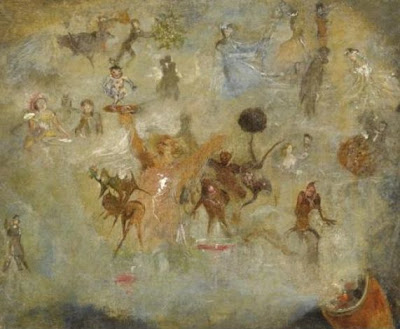
oil on canvas
25.5 by 30.5cm.; 10 by 12in.
ESTIMATE 10,000 - 15,000 GBP
Jeremy Maas, Pamela White Trimpe, Charlotte Gere, Victorian Fairy Painting, exhibition catalogue, 1997, illus.
p.19, fig.5
Pipe-Dreams is perhaps Fitzgerald's most remarkable painting, depicting apparitions appearing from the smoke of an opium pipe. The visions are a combination of romantic, nightmarish and humorous subjects and suggest an intimate knowledge of the effects of the opium derivatives, laudanum and chloral, favoured by the drug addicts of the nineteenth century. Although many potentially dangerous and addictive narcotics were readily available over the counter at many Victorian pharmacies, towards the end of the nineteenth century opium was increasingly perceived
to be a great threat to the moral fabric of the country. Following the two Opium Wars, the trade from China to Europe expanded greatly, from a hundred tons in 1800 to two thousand tons in 1837. The advances in steam navigation in the 1870s led to an influx in Chinese immigrants to Europe and with them came a ready supply of the
drug and the proprietors of the dens that opened in the slums of the larger cities. Newspapers and authors portrayed London as the European centre of opium smoking particularly around Limehouse and Shadwell, but this was unjustified and the number of regular visitors to London opium dens probably did not exceed a few hundred
and no nineteenth century photograph has ever been found of a London opium smoker. However several artists made the smoking of opiates subjects for their pictures, such as John Wimbush who painted An Opium Den at Lime Street c.1889 (sold in these rooms, 9 December 2008, lot 127).
Fitzgerald's fairy-folk were inspired by the work of Hieronymus Bosch from the prints that were widely available in the mid nineteenth century and collected by artists. The present picture captures the same visionary world of goblins and elves and of lovers kissing beneath mistletoe whilst the opium pipe gives the painting a modern relevancy.
No comments:
Post a Comment